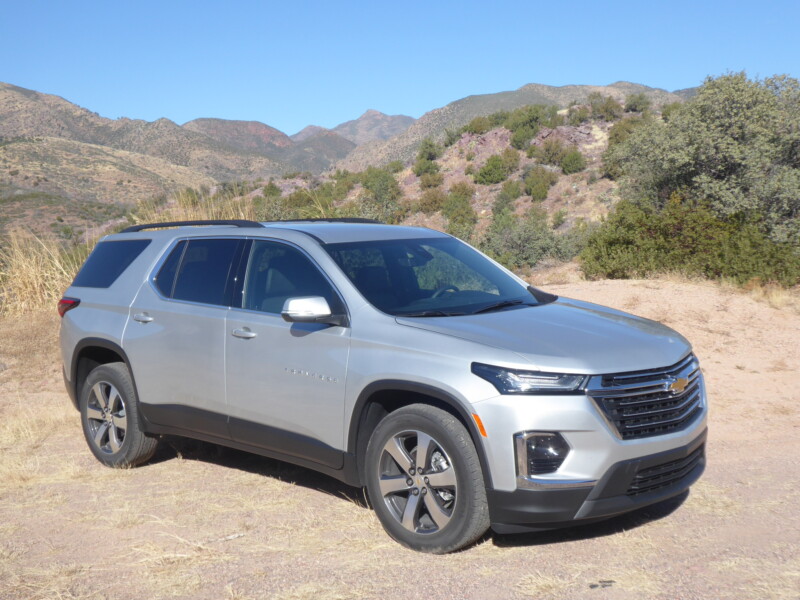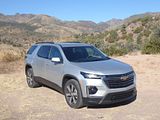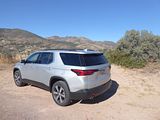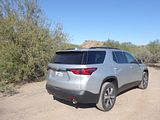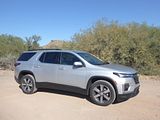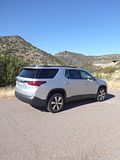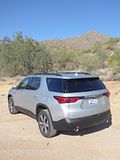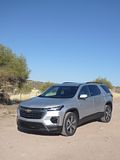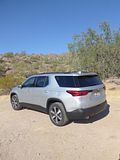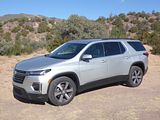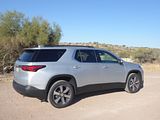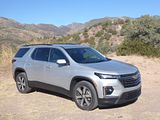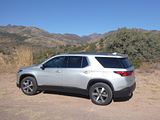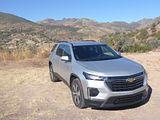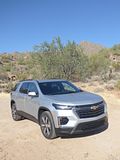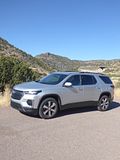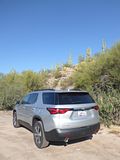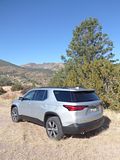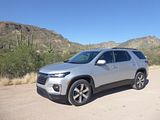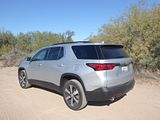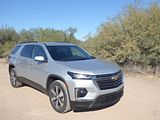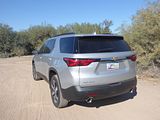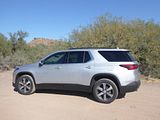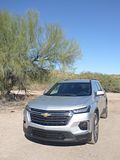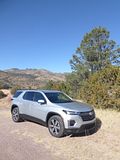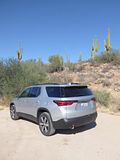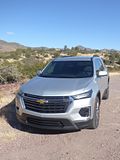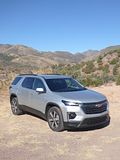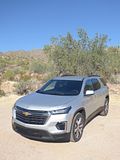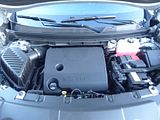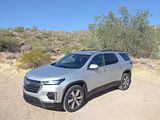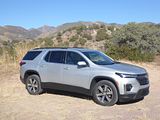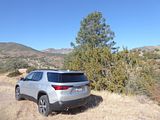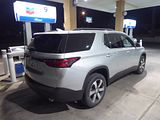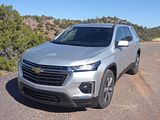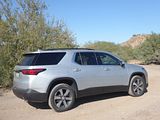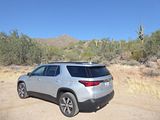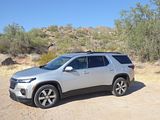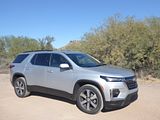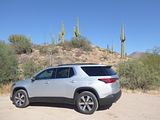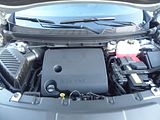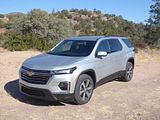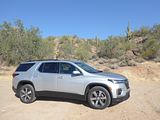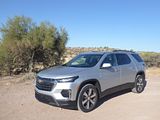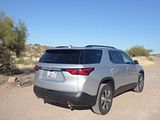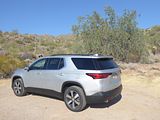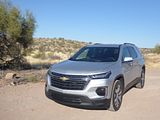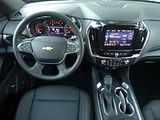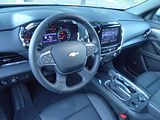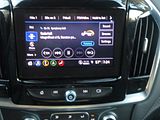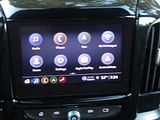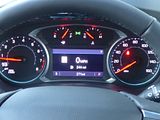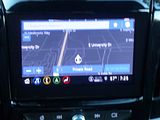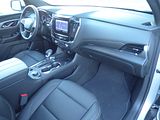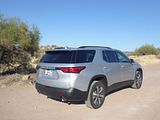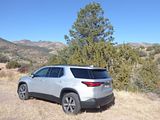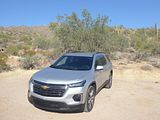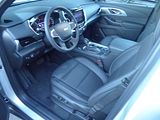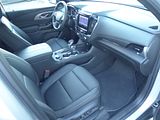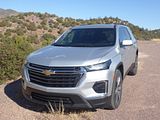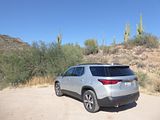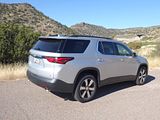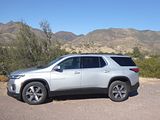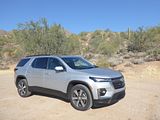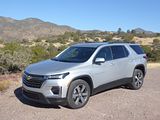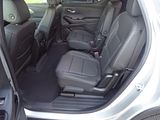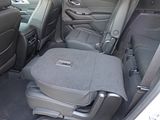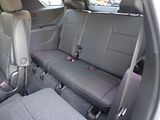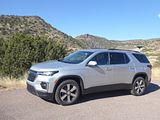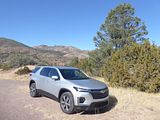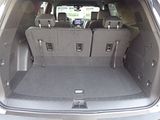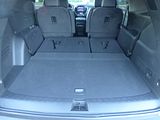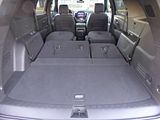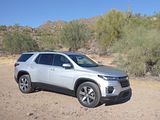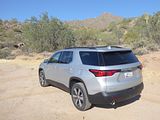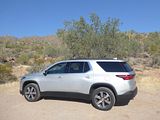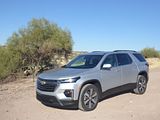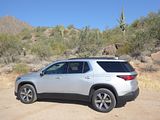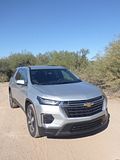A few years into the twentyfirst century, the automotive sector started to move away from truck-like SUVs into what became known as the crossover, which appeared to combine the best of both worlds, with a more car-like driving experience but all the advantages of space and raised driving position of the SUV. GM followed the market with a new platform known as Lambda which would eventually underpin four vehicles that looked quite distinct from each other. The most luxurious and costliest of the quartet, the Buick Enclave was the first to appear, at the 2006 New York Auto show and this was then followed by the Saturn Outlook and GMC Acadia with the cheapest of the four, and the one that would sell in the largest quantity, the Chevrolet Traverse arriving in showrooms in the autumn of 2008 following a launch at the Chicago Auto Show in February of that year. Far from exciting, the Lambda family of vehicles were very practical, spacious vehicles that were exactly what many people were looking for and they sold well. The Outlook had a short life, as GM decided to close down the Saturn brand in 2009, but in a move that surprised everyone, its front end was used for the facelifted GMC Acadia a few years later. When it came to replacing what was now a family of three cars, again, GM staggered the launch. Once more, the second generation Buick was the first to reach the market, and this was followed by an Acadia that surprised everyone as it was smaller than its predecessor. That led to lots of speculation as to whether the Traverse would follow suit or not. With the launch of the new model, available from late 2017, as a 2018 model year car, we learned that it did not, and the reason why became clear when a few months later Chevrolet squeezed the Blazer into their line-up to fit between the Equinox and the Traverse. Indeed new Traverse is now a very large car indeed, at 17 foot 1” but that, it seems, is what US buyers seem to want. The first generation Traverse featured heavily in the Hertz fleet throughout its life but there have been relatively few of the second generation car on fleet, so it is only now, just after the mid-cycle facelifted 2022 model year cars have arrived that I have managed to source one, with this brand new 2022 model year car which had only a couple of hundred miles on the clock, which I picked up from Hertz’ Sky Harbor facility at Phoenix airport. I thought the first Traverse was a very decent car in its class so wondered what I would make of this one.
All Traverse models get the same engine, a 3.6 litre V6 unit which generates 310 bhp and standard front wheel drive. That’s a decent output, but then this is a large and heavy car. Even so, it endows the Chevy with strong acceleration. The V6 has a pleasant engine note to it, just loud enough so you can hear it at idle, but pleasingly civilised and quiet once you get underway. The engine is very smooth and it is well matched to the nine speed automatic transmission with gearchanges almost imperceptible. With 266 lb/ft of torque, there is strong mid-range acceleration. I should point out, of course, that my experience with the car was one-up. Fill the Traverse with 6 more adults and some luggage and no doubt it would not feel quite as brisk. There is a stop/start system fitted. The car was supplied with the fuel tank less than full, and as I did not use that much fuel, it is hard to be sure of the economy I actually achieved.
This is a big car and there are times when you will be more than aware of this. That is especially the case when you are manoeuvering it or trying to park. You can’t really judge where the front is, or even the side, and it is only the fitment of the rear-view camera that means you can judge the back end, which is a long way behind you. On the road things are a lot better, of course, and the car belies its size to a considerable extent. It is never going to feel like a sports car or be that nimble, but it is easy to place on the road and in traffic. The steering is light but the assistance is not overly done, so there is some feel which helps to give an idea where the car is headed. Handling is very much as you might expect. This is a large car with a relatively high centre of gravity so it is not envisaged that it will be flung into bends with abandon in quest of driving thrills. It does hang on well, with good grip but it does understeer even from relatively low speeds. More importantly, the ride is good despite the use of large 255/55 R20 wheels. The brakes are smooth and powerful in operation. There are lots of electronic safety systems part of the standard spec now. The Lane Keep Assistance was as annoying as these systems always prove to be, but even more irksome was the fact that you cannot put the car in gear until you have fastened the safety belt which is a particular nuisance if you are just moving it a few feet, which is what I was doing when taking photos. Also included is forward collision warning, a speed limit recognition capability and auto dipping lights.
The interior of the Traverse sports much of the current GM look, all presented with plenty of leather on this version of the car and with a nice quality to it, though there are still some hard plastics in places which remind you that this is not a car with premium ambition in the mid-range trim version of the test car. There are two large dials for speedometer and rev counter with smaller ones for fuel level and water temperature between them as well as the trip computer display in the instrument cluster. All are clear and easy to read. The two column stalks will be familiar to anyone who has driven any other recent GM product and the lights operate from a rotary dial on the dash to the left of the wheel. There are touch pads used on the steering wheel boss for cruise control and audio repeater functions. The centre of the dash includes a neatly integrated 8” colour touch screen featuring the latest GM system, with minimal buttons associated with it. This is connected to a Bose sound system and the spec included XM Satellite radio, navigation, Apple Car Play and Android Auto. This system is a lot better and easier to use than previous generations of MyLink, though the trend to remove more and more of the buttons, which everyone is doing, is regrettable. Beneath this unit are touch pads to operate the tri-zone climate control system. Included the spec is wireless phone charging.
This was the Leather version of the LT trim, which meant that seat upholstery was indeed covered in the real stuff from a cow. The quality of it was decent, which is not always a given. There is a wide range of electric adjustment including lumbar support. You do sit quite high, which I guess is part of the point of a crossover, but even so there is plenty of headroom. There is a telescoping wheel, moving in/out as well as up/down, so it was easy to get the driving position that suited me. In LT Leather trim, the seats have a heating function.
The second row of seats are presented “captain’s chair” style, which means two separate seats with plenty of space between them. Indeed it is space which characterises things here. Legroom is plentiful even if the front seats are set well back, and there is lots of headroom. The seats are on sliders, so you really can stretch out here if you want. There are 2 USB ports, as well as a power outlet and separate controls for climate control and odds and ends can go in the seat back map pockets or the door bins. Access to the third row is by tipping the seat forward, but you can only do this from the passenger side, which is a sensible safety feature, I think. Unlike a lot of 7-seater cars, access is pretty good, so you can get in and out without undue difficulty and once installed, there is also plenty of space. Three adults might be a bit cosy from a width point of view, but would still seem do-able, and there is plenty of legroom, and headroom. The angle of the seat is such that you do not end up with that knees in chin experience you often get. Those sitting here also get 2 USB ports, and there are cupholders moulded into the side trim and roof vents will bring cooled or heated air to you.
The tailgate is electrically assisted both when opening and closing it, which is just as well, as it is large and heavy. The boot area is small when the third row of seats is erect, though there is a cubby under the floor for a few smaller items. But once you start folding seats down, then you get a massive load area. The third row of seats are split 60/40, and as the second row comprises those captain’s chairs, then effectively they will fold down on a 50/50 basis. The resulting area is completely flat, though there is a gap in the floor area between the second row seats. You would have to have a truly phenomenal amount of luggage not to be able to fit everything in here, but if you really do need even more carrying capacity, there are roof rails. Inside the cabin, there is a decently sized glove box and a deep cubby between the seats as well as pockets on the doors and there is a handy slot in the passenger side of the centre console.
The 2022 Chevy Traverse comes in six trims: LS, LT Cloth, LT Leather, RS, Premier, and High Country. All trims are equipped with a V6 engine, and each is available with either front- or all-wheel drive. The entry-level Traverse LS starts at $33,700, and it’s outfitted with a 310-horsepower V6 engine, a nine-speed automatic transmission, and front-wheel drive. Upgrading to all-wheel drive costs $2,000. Standard features include a 7-inch touch screen, Apple CarPlay, Android Auto, Bluetooth, six USB ports, satellite radio, a six-speaker stereo, a Wi-Fi hot spot, proximity keyless entry, push-button start, and tri-zone automatic climate control. Additional standard features include cloth upholstery, second- and third-row bench seats (eight-seat layout), rear-seat alert, a rearview camera, and 18-inch wheels. The Chevy Safety Assist package also comes standard, and it includes LED headlights with automatic high beams, forward collision warning, pedestrian detection, forward automatic emergency braking, lane departure warning, and lane keep assist. The Traverse LT Cloth costs $36,200 with front-wheel drive and $38,200 with all-wheel drive. This trim adds a power-adjustable driver’s seat, second-row captain’s chairs (seven-seat layout), wireless device charging, blind spot monitoring, rear cross traffic alert, and rear parking sensors. The Traverse LT Leather starts at $39,900 with front-wheel drive and $41,900 with all-wheel drive. This trim gains leather upholstery, heated front seats, a power-adjustable front passenger seat, a heated steering wheel, an 8-inch touch screen, remote start, and a power liftgate. The Traverse RS trim is priced at $44,200 with front-wheel drive and $46,200 with all-wheel drive. This trim adds 20-inch wheels, adaptive cruise control, navigation, a surround-view parking camera system, a rearview mirror with an integrated camera display, a 10-speaker stereo, and a 120-volt household-style power outlet. The Traverse Premier costs $46,600 with front-wheel drive and $49,200 with all-wheel drive. This trim adds ventilated front seats, heated second-row seats, the Safety Alert Seat system, and a hands-free power liftgate. The range-topping Traverse High Country starts at $51,200 with front-wheel drive and $53,400 with all-wheel drive. This trim gains a power-folding third row, a panoramic sunroof, and a trailer hitch guidance feature for the rearview camera.
My over-riding memory of the Traverse will be of its size. This really is a big car, with lots of space in it, and if that is what you are looking for, you will find lots to like here. The Traverse goes well, is smooth and refined and is easy to drive, if not always to park. The interior is finished to a good standard for a non-premium car and there are lots of practical touches. There are no real weaknesses here, so whether this is car for you, or whether you would prefer one of the other large 7-seater on the market – and there are plenty of alternatives on the US market – will come down to personal choice and perhaps how much you really need all that space. If you only use the third row occasionally, then the Mazda CX-9 and Kia Sorento are better to drive, a bit more economical and not quite so big to have to park up. The two unknowns, to me, are the Hyundai Palisade and the Kia Telluride. They have had rave reviews and the fact that they are not in the rental fleets, who buy lots of other Hyundai and Kia products, perhaps tells you that they can’t satisfy demand for them, so selling a whole load of them at rental car prices when you can get full retail price is not a place where they’ve had to go even three years after launch.

